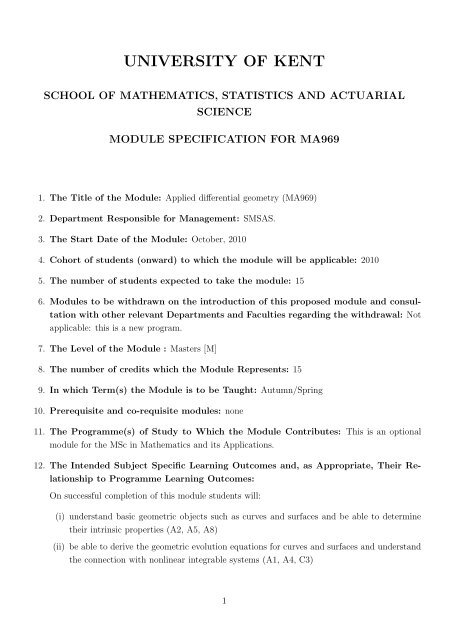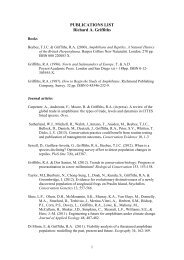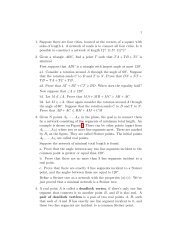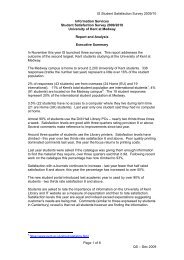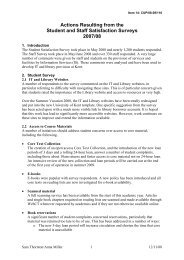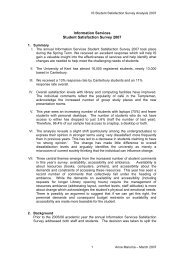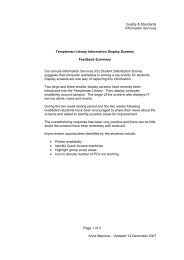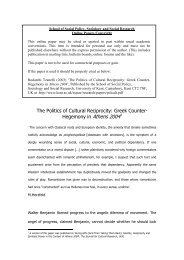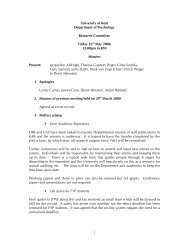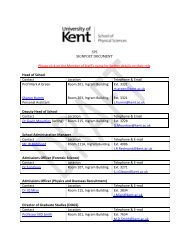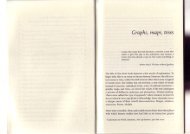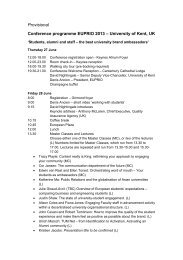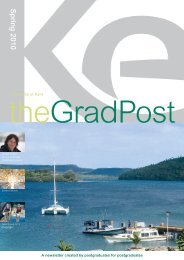Applied Differential Geometry - University of Kent
Applied Differential Geometry - University of Kent
Applied Differential Geometry - University of Kent
Create successful ePaper yourself
Turn your PDF publications into a flip-book with our unique Google optimized e-Paper software.
UNIVERSITY OF KENT<br />
SCHOOL OF MATHEMATICS, STATISTICS AND ACTUARIAL<br />
SCIENCE<br />
MODULE SPECIFICATION FOR MA969<br />
1. The Title <strong>of</strong> the Module: <strong>Applied</strong> differential geometry (MA969)<br />
2. Department Responsible for Management: SMSAS.<br />
3. The Start Date <strong>of</strong> the Module: October, 2010<br />
4. Cohort <strong>of</strong> students (onward) to which the module will be applicable: 2010<br />
5. The number <strong>of</strong> students expected to take the module: 15<br />
6. Modules to be withdrawn on the introduction <strong>of</strong> this proposed module and consultation<br />
with other relevant Departments and Faculties regarding the withdrawal: Not<br />
applicable: this is a new program.<br />
7. The Level <strong>of</strong> the Module : Masters [M]<br />
8. The number <strong>of</strong> credits which the Module Represents: 15<br />
9. In which Term(s) the Module is to be Taught: Autumn/Spring<br />
10. Prerequisite and co-requisite modules: none<br />
11. The Programme(s) <strong>of</strong> Study to Which the Module Contributes: This is an optional<br />
module for the MSc in Mathematics and its Applications.<br />
12. The Intended Subject Specific Learning Outcomes and, as Appropriate, Their Relationship<br />
to Programme Learning Outcomes:<br />
On successful completion <strong>of</strong> this module students will:<br />
(i) understand basic geometric objects such as curves and surfaces and be able to determine<br />
their intrinsic properties (A2, A5, A8)<br />
(ii) be able to derive the geometric evolution equations for curves and surfaces and understand<br />
the connection with nonlinear integrable systems (A1, A4, C3)<br />
1
(iii) have broadened their experience with the basic concepts in Riemannian geometry such as<br />
metrics, connections and curvatures(A5, A6)<br />
(iv) have developed awareness <strong>of</strong> modern applications to mathematical physics, computer vision<br />
and image processing (A1, B2)<br />
13. The Intended Generic Learning Outcomes and, as Appropriate, Their Relationship<br />
to Programme Learning Outcomes:<br />
On successful completion <strong>of</strong> the module students will<br />
(i) have an enhanced ability to reason and deduce confidently from given definitions and constructions<br />
(A2, B4)<br />
(ii) have an enhanced ability to associate abstract geometrical concepts with their applications<br />
(A5, B4)<br />
(iii) have matured in their problem formulation and solution skills (B1, B2, D4)<br />
(iv) have consolidated their grasp <strong>of</strong> a wide variety <strong>of</strong> mathematical skills and methods (A1,<br />
A4, A8, A9, C3)<br />
14. A synopsis <strong>of</strong> the Curriculum The main aim <strong>of</strong> this module is to give an introduction to the<br />
basics <strong>of</strong> differential geometry, keeping in mind the recent applications in the analysis <strong>of</strong> pattern<br />
recognition, image processing and computer graphics.<br />
(a) Theory <strong>of</strong> curves: Plane and space curves. Euclidean and affine invariants <strong>of</strong> plane curves.<br />
(b) <strong>Geometry</strong> <strong>of</strong> surfaces: Metrics on regular surface, Curvature <strong>of</strong> a curve on a surface, Gaussian<br />
curvature and mean curvature, Covariant derivative and geodesics, The Euler-Lagrange<br />
equations, Minimal surfaces.<br />
(c) Evolution <strong>of</strong> curves and surfaces as integrable systems: Invariant curve evolution. The mean<br />
curvature flows. The connection with integrable systems. The modified Korteweg de-Vries<br />
equation. Soliton solutions and the corresponding curves.<br />
(d) Curves in Riemannian manifolds: Riemannian metrics, connections, curvatures and geodesics.<br />
Curves evolution in Riemannian manifold with constant curvature.<br />
(e) Modern applications include: Moving frames, invariant signatures in pattern recognition,<br />
Poisson manifolds and Hamiltonian systems, and multiple view geometry in computer vision<br />
(the emphasis and the topics may vary from year to year).<br />
15. Indicative Reading List:<br />
Books:<br />
Lectures on differential geometry, I.A. Taimanov, EMS series <strong>of</strong> lectures in Mathematics, 2008.<br />
Bäcklund and Darboux transformations: <strong>Geometry</strong> and modern applications in soliton theory,<br />
C. Rogers and W.K. Schief. Cambridge university press, 2002.<br />
2
Numerical geometry <strong>of</strong> images, theory, algorithms and applications, R. Kimmel, Springer Verlag,<br />
2003.<br />
Multiple View geometry in computer vision, R. Hartley and A. Zisserman, Cambridge university<br />
press, 2nd ed. 2003.<br />
Articles:<br />
Lectures on moving frames, P.J. Olver, preprint, <strong>University</strong> <strong>of</strong> Minnesota, 2008.<br />
On integrable systems in 3-dimensional Riemannian geometry, G. Marí Beffa, J.A. Sanders, J.P.<br />
Wang. Journal <strong>of</strong> Nonlinear Science, 12:143–167, 2002.<br />
16. Learning and teaching methods<br />
Number <strong>of</strong> contact hours: 24-36<br />
Total study hours: 150<br />
Contact hours comprise a mix <strong>of</strong> lecture and example class.<br />
Student study hours would be distributed between consolidation <strong>of</strong> lecture material, the working<br />
<strong>of</strong> exercises on exercise sheets, assessed exercises, using Maple to obtain results and check their<br />
work, independent reading and exam preparation.<br />
17. Assessment methods and how these relate to testing achievement <strong>of</strong> the intended<br />
learning outcome:<br />
Assessment: The module is assessed on the basis <strong>of</strong> examination (70%), coursework (30%)<br />
Examination: A 2 hour written examination in Term 3 that consists <strong>of</strong> multi-part questions<br />
requiring a mix <strong>of</strong> long and short answers to test at varying levels <strong>of</strong> pr<strong>of</strong>iciency the learning<br />
outcomes (12(i-iv), 13(i-iv)).<br />
Coursework: This consists <strong>of</strong> open-book assignments <strong>of</strong> unseen problems, a mid-term class test,<br />
and exercises based on material the students read independently (12(i-iv), 13(i-iv)).<br />
18. Implications for Learning Resources<br />
Staff: Convener and moderator<br />
Library: books as requested<br />
IT and Space: suitable rooms for lectures and classes (max <strong>of</strong> 3 per week)<br />
19. A statement confirming that, as far as can be reasonably anticipated, the curriculum,<br />
learning and teaching methods and forms <strong>of</strong> assessment do not present any nonjustifiable<br />
disadvantage to students with disabilities<br />
The expectations <strong>of</strong> SENDA have been incorporated in the curriculum design and students<br />
having documented individual learning needs are advised by the Dyslexia & Disability Support<br />
Service. Therefore, as far as can be reasonably anticipated, the curriculum, learning and teaching<br />
methods and forms <strong>of</strong> assessment do not present any non-justifiable disadvantage to students<br />
with disabilities.<br />
3
Statement by the Director <strong>of</strong> Graduate Studies<br />
“I confirm I have been consulted on the above module proposal and have given advice on the<br />
correct procedures and required content <strong>of</strong> module proposals”<br />
................................................................<br />
Director <strong>of</strong> Graduate Studies<br />
Print Name<br />
..............................................<br />
Date<br />
Statement by the Head <strong>of</strong> School<br />
“I confirm that the Department has approved the introduction <strong>of</strong> the module and, where the module<br />
is proposed by Departmental staff, will be responsible for its resourcing”<br />
.................................................................<br />
Head <strong>of</strong> School<br />
Print Name<br />
..............................................<br />
Date<br />
4


